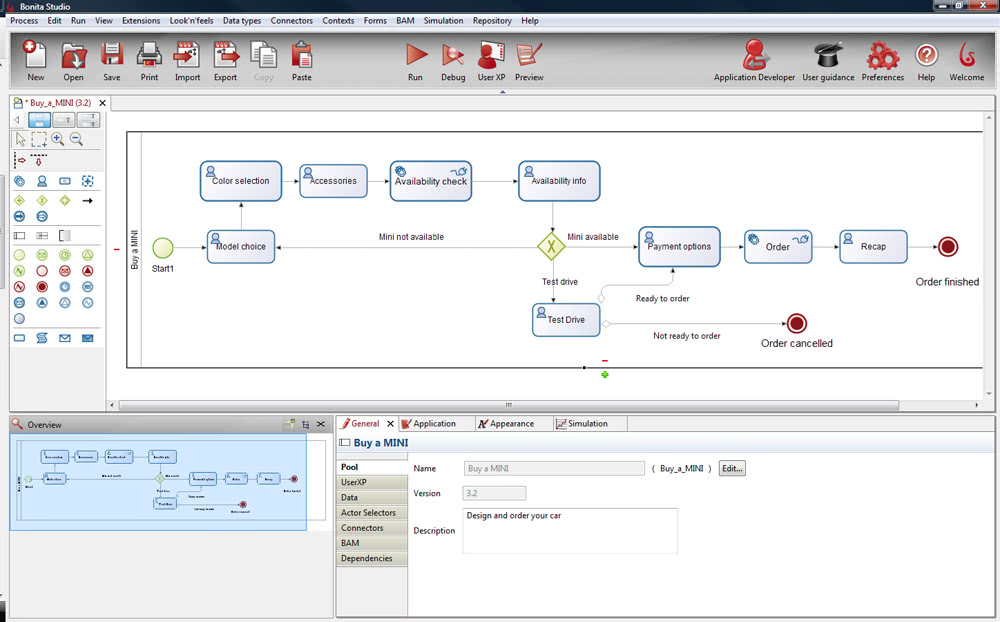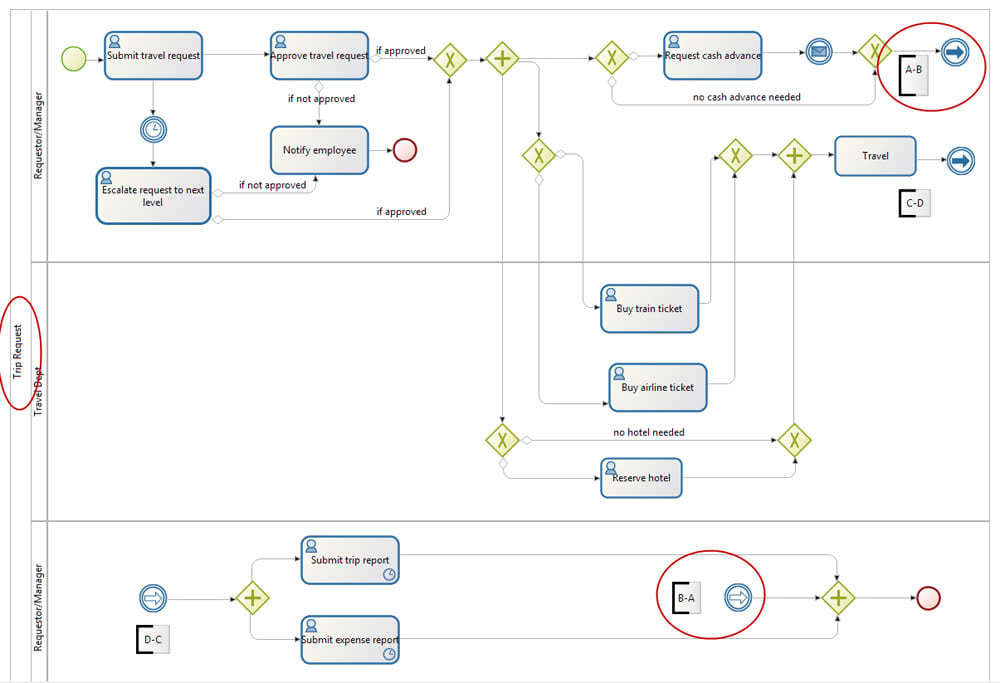Business Process Management
BonitaSoft and the Democratization of Open Source Business Process Management

Business Process Management (BPM) software has typically been seen as the domain of huge developers like IBM and Oracle and the huge enterprises who can afford their solutions. BonitaSoft contends, however, that the benefits of BPM can extend to small and medium-size businesses too, and they know how to do it. We spoke to BonitaSoft vice president of marketing Mac McConnell to find out more about how open source–and a highly competitive price point–are helping in its goal of democratizing BPM.
What was the chief inspiration behind starting BonitaSoft? Was there an outstanding need you saw in the BPM segment that wasn’t being met by competitors at the time?

WEBSITE: www.bonitasoft.com
FOUNDED: 2001
LOCATION: Grenoble, France; San Francisco
CUSTOMERS: Egyptian Stock Exchange (EGX), Old Dominion University, Konica-Minolta
That’s really where we saw the opportunity to found BonitaSoft and bring the product to market–as a very powerful system offered at a value system price. That’s really what it was all about for us, was being able to democratize the world of business process management and BPM suites to really anybody who sees value in running a more efficient business.
BPM has come to be a crowded segment in business software. Keeping in mind what you just mentioned, how do you differentiate yourselves from the competition?
There are two ways we really like to differentiate. The one I already mentioned, which is around our price point, and being more affordable than a lot of our peers.
The second way is ease of use, and that’s something we take very seriously. We really define ease of use as two distinct areas: one is around designing and developing processes. This is through the Bonita Studio, where it’s really a whiteboard-type environment. You follow the BPMN, Business Process Management Notation, of standards to design your process. The other side of ease of use is the end user, the humans that are going to be accomplishing various tasks within a process, making sure that they have a very easy-to-use intuitive portal that they can identify which tasks need to be completed in, help them prioritize and make sure they have the information they need to complete that task.
So between price and ease of use those are the two primary ones, but we also, as another way to differentiate from our peers, turn processes into fully-running business applications out of the BonitaSoft solution. When I say business application I mean you got a way for outsiders–let’s say it’s a situation where maybe you’re doing egovernment solutions–so all so all of our citizens are needing to interface with an application to do something like renew a driver’s license, so then that information is flowing through the back end programming–which is the process design–out to somebody who maybe at the Department of Motor Vehicles, and needs to either approve or reject or request more information before the authorize the renewal of that driver’s license.
What does being open source bring to a BPM system? What do you guys get out of open source as a company, and what do your users get out of it?
This may be a good time to offer a little history on our product. Bonita, as a BPM suite, was first founded in 2001 as an open source project. The technology went through a number of iterations in an academic environment. Our CEO and co-founder, Miguel Valdes-Faura, brought that to the big system integrator in New York. Then they developed the project even further. Then it was finally at the point where the open source product really needed to stand on its own and become a commercial offering. That’s what was founded by Miguel and our two other co-founders.
So we have a long history in open source. One of the big benefits is that BPM has so many different use cases; it’s so much different from a company like SugarCRM, where they have a very specific use gauged around sales force automation and management. Or talent management and HCM for example. That could be a broad-use case, but it’s still very specific. In contrast, the thing about BPM is you’re really only limited by your imagination. Depending on what the process is, you can begin to automate and manage better with BPM. That can be anything from human resources, it could be corporate finance, it can be regulatory compliance… and I can keep going with this list. But I think there’s really two interesting things that open source brings. I think for us, what we get is cutting-edge feedback from our open source users. That can be new use cases, on how they’re tweaking the open source software in their organization and coming up with ideas we’ve never even thought about.
I’ll give you an interesting example: we’ve got an open source customer in the Egyptian Stock Exchange (EGX). They use BonitaSoft for various processes, but one of the ones I never even thought about was compiling stock exchange indexes at the end of the day using a BPM suite. That was something we would have never known was a potential use case for BPM and for BonitaSoft if our community hadn’t been active. Because we have such a broad set of use cases, the feedback we get from the community is even more important than it is for some other open source projects that may be far more narrow in their use space.
With the amount of attention you give to user feedback has your core offering changed or remained pretty much the same since you began?
The core offering has stayed the same. So we’ve got the Bonita Engine, Bonita Studio and the Bonita User Experience. Those three elements have really stayed the same, the cores and modules of the software. But where our community has really helped out is in improving the Bonita Studio, which is the process designer. They’ve really come up with a lot of recommendations for ergonomics and layout within the studio. That’s gone through a lot of feedback. The other thing we get is we’re very open with our bug tracker; so if I find a bug in our software and I register with that bug tracker it’s the same bug tracker our community is using. So we’ve been able to identify bugs more quickly both internally and externally.
The one area where our community has just been terrific is on what we call connectors. We’ve got a very open, more Java-based solution. We use a Java API as well. That’s allowed us to develop a whole set of connectors to outside systems — everything from Salesforce.com to various SAP suites, to Jaspersoft — really any application they can pick up with the API. I would say — and I don’t know the most recent numbers — but at least 50 percent of those connectors have come from community contributors. We went out and interfaced with these people and said, hey, this is great. We’ve doubled checked it for viability and QA’ed it, and if it works great we’d love to give you credit and apply it in our official package.
Have you noticed any strong correlations in what kinds of organizations that are using your products?
There are a couple of things we’re seeing. We’re seeing adoption at very large companies and smaller companies. Let me just give you some definition: a large company would be 5000 employees and above; and smaller companies would be 100 to 1000 employees. We’re seeing a lot of pickup for our solution in inquiry in those two areas. That’s a little surprising because I would have actually thought a year ago that it would be the reverse, that it would be those companies in the 1000 to 2500 or 1000 to 5000 range that would have been primary adopters, because they’re in that unique position where they’re big enough to be very inefficient and not able to move very quickly, but also may have run into a bit of a cash crunch or operational crunch due to the recent economic problems.
We’re value priced, so that makes us very attractive to smaller companies, but then what we’re also seeing is the open stack becoming very common in really large companies. I think we’re riding that wave a little bit, both in the large company sector, but also in the government sector. We’re also seeing a bunch of adoption in the financial services industry, specifically large banks and insurance companies. That is, I think, being driven by regulation. They’re constantly changing regulations in the financial services industry. One of the wonderful things about BPM is its flexible logic through the design of the Studio. So if something changes you don’t have to start rewriting hundreds, if not thousands, if not tens of thousands of lines of code. You can just adjust your process model to add in a regulatory step that’s been mandated.
We’ve also seen a lot of software developers start to adopt BPM, specifically as an engine behind their software, their applications, really. That puts us into an OEM environment where these software companies are seeing that they can develop more quickly using BonitaSoft.
Having started out based in and selling to Europe, what kind inroads have you been making into the North American market?
We opened our San Francisco office in 2011. It’s been going very well, we’re meeting our planned target, but with that said, it is difficult because a lot of our larger competitors–Oracle, IBM, Pegasystems, Cisco–this is their backyard, and they have some very entrenched relationships, and obviously some huge brand recognition, particularly in the BPM space. So while I’m very positive, and we’re doing a great job, it’s still difficult to be 30 miles away from Oracle and be staring them in the face every time I get up and go to work because they can be a very dominant presence, as can IBM and the rest of the players.
What’s the biggest challenge you guys are facing right now and how are you addressing it?
Technology-wise I don’t think there are any major challenges we’re facing. Once again, we’re based on a Java platform, so Java’s stayed nice and stable over the last few years and we think it will continue to be.
I think the more difficult elements we’re running into is on the side, where, if you talk to any business executive, you talk to any IT guy, they know that processes at companies inefficient, and they know that there are technologies out there to make those processes more efficient. But the implementation is where the personality of a company can really come in and say “we want to be better and we want more operational efficiencies within our organization.” It’s almost not a software problem, it’s a change management or personality problem. Trying to overcome some of that through the marketing and sales efforts at BonitaSoft can be difficult. We can find the perfect person who is ready to buy, but when they look at what’s going to be required to do all the changes within their organization to adopt BonitaSoft can sometimes be where we run into trouble.
Where do you see the BPM segment going in the next three to five years. What sort challenges and opportunities do you foresee?
I think the space is going to grow. Gartner recently came out with numbers that said by 2015 BPM should be a $15 billion industry. That’s probably right depending on how you define the borders of the industry. All of us who are in BPM solutions are going to have to get behind better explaining to the potential buyer what we do and how they will benefit from it. I think there’s a lot of noise because there are a lot of players in the space, and we’re all trying to make a name for ourselves, but we’re not doing a good job of supporting BPM as an approach to running your business. If we do that, the tide will rise, and all boats will rise with it.
Want more information on the best BPM software solutions?
We’ve compiled the top product reviews, blog posts and premium content on our business intelligence software research page. Here you’ll find all the information you need to choose the right solution. Also, be sure to compare the leading BPM products in our Top 10 Business Performance Management Software report, where we give you the lowdown on pricing, key features and tech models.







